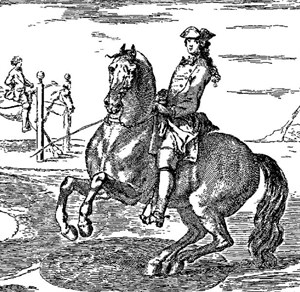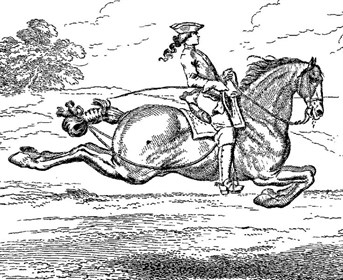|

|
This article has appeared previously with Equestrian Life. To see what is in our latestn digital issue, please click here.

Pirouette on the left, Cavalry school, La Guerinière ed 1733.
By Kerry Mack
Eleanor Roosevelt thought curiosity was the most useful quality a child could be endowed with. It can help riders too. Having read and reread Podjasky’s masterpiece “The complete training of horse and rider’ and finding it to be incredibly helpful and practical, my curiosity was aroused by his description of de la Gueriniere’s book “Ecole de Cavalerie” (School of Horsemanship) as “the most revolutionary book on riding of all times”. Podjasky goes on to say “there is no need to discuss Gueriniere’s teachings in detail in this work, not because they are not sufficiently interesting, but because they are applied unaltered at the Spanish Riding School and may be seen there in daily use”.
You can read Kerry Mack's latest article in the February issue of Equestrian Life magazine here.
Now doesn’t that arouse your curiosity? Wouldn’t you like to know what this Frenchman of the Enlightenment period had to say that is still the foundation of the bastion of Classical dressage, in this modern era where debate rages about Classical (often so-called) versus Modern Dressage, and when competition riders are often demonised as anti-classical by outspoken critics? De la Gueriniere lived in the time when the greatest thinkers of the time started to espouse the benefits of observation of the natural world to learn about it. This was the precursor of the scientific method and although it sounds obvious to us this was a radical departure from the previous thinking which was largely determined by the church. The enlightenment was from the 1650’s to 1780’s, the age of reason, time of the first encyclopaedia, and the philosophers and fathers of science including Spinoza, John Locke, Voltaire, Rousseau.
I was certainly curious and found it was incredibly easy to obtain a copy of the excellent English translation by Tracy Boucher, posted to me from sunny Brisbane at less than half the price on Amazon, who didn’t actually have a copy anyway. And what a curiosity and a gem it is. It has the beautiful illustrations of Charles Parrocel who was one of the greatest equestrian artists of the time...

La Cabriole, Cavalry school, La Guerinière ed 1733.
School of Horsemanship is actually a compilation of parts published between 1729 and 1731 when de la Gueriniere was the director of the riding school of the court of Louis XIV at the Tuileries and Versailles. He held the position until his death in 1751. The book has three parts. The first part deals with what Gueriniere saw as the “knowledge of the horse’ which is essentially anatomy and conformation, aging the horse by looking at the teeth, (which was still an essential skill in the 1970’s when I was young, but is becoming irrelevant in the era of micro chipping), saddlery and fitting it including bitting, and shoeing, and feeding. Anatomy etc hasn’t changed, but the reader is rewarded with curious gems such as how to detect ‘bishopped” teeth, where the unscrupulous seller has falsified the age of a horse by hollowing and blackening the teeth!
A significant chapter describes and illustrates natural gaits (walk, trot and canter); the faulty gaits including the amble, and the artificial gaits including piaffe and passage. This emphasis on the correct gaits is reflected in the emphasis in the modern training scale on rhythm.
The third part of the book is essentially state of the art veterinary practise as practised in 1731! Now this is a real curiosity, filled with advice about herbal treatments and barbaric practises such as desoling, bleeding, cutting the tongues of horses with the unfortunate habit of hanging the tongue out when being ridden. You can learn how to treat quittors, horned attaint, glanders and farcy! Thank goodness for modern veterinary medicine. You can also find out how to add white markings with lead shot inserted under the skin.
It is the second part of the book which is full of the wisdom which persists as Classical Dressage. Part Two is titled “on the manner of training horses according to the various uses for which they are intended” and starts with general advice on training and finishes with specific advice for training horses for different purposes including war horses, hunters and carriage horses.
The first chapter is “Why there are so few horsemen and the qualities necessary to become one”. The answer essentially that it takes much practise with true principles. Interestingly he says one must find the principles from the Grand Masters of the Art and the writings of the Frenchman de la Broue and the duke of Newcastle. The principles must perfect nature. Understanding theory is essential. “...in order to arrive at excellence in this art one must be prepared for the difficulties of practice through clear and solid theory”. He also says one should “love horses, ..Have vigour and boldness and much patience, ..But not brutal force and foolhardiness.’ A good horseman must use a “gentle force …with ease, equilibrium and grace, …and proceed with constant progress in knowledge”.
De la Gueriniere goes on to discuss different temperaments, the use of whip and spur and other instruments, then reviews terminology, and the movements of the legs in different gaits (recognise the emphasis the training scale places on rhythm), then he addresses the position of the rider. He highlights the importance of balance over grip, and the need to be able to remain in the correct posture however the horse moves.
With regard to contact, the third quality on the modern training scale, he defines a good hand as being light, gentle or firm. A light hand is one which never touches the bars of the mouth. A gentle hand is one which feels the effect of the bit slightly without giving too much contact and a firm hand is one which holds the horse in full contact. He describes that these effects should be used sequentially, give rein (without dropping the contact) then resume a light and then gentle then firm contact. ‘the contact should never be released suddenly nor made firm again suddenly as this would offend the horse and cause it to toss its head” ’The gentle hand must always precede and follow the firm hand’. The rein is given after the half halt at the moment the horse is coming back onto its haunches “the horse bending its haunches just as contact is released, must necessarily remain light in the hand, having no other support for the head.’ Later he has a similar exploration of the qualities of the mouth of the horse.
He goes on to emphasise that the trot is the most important gait for training agility in young horses. He describes use of the halt, half halt and rein back to ‘put the horse on its haunches’. The half halt is done by “pulling back the bridle-hand towards the body without bringing the horse to a complete stop”. This he says cause horses less “stress and apprehension “than a full halt.
One of the most important contributions of la Gueriniere was the invention of the shoulder in. Gueriniere invented the shoulder in at least in part to develop the suppleness of the shoulders and to train sideways obedience to the rider’s leg. De la Broue favoured the square for this , and the Duke of Newcastle used the circle. Newcastle used the circle with the quarters out to supple the shoulders but described that this did place the weight on the forehand. De la Gueriniere developed the shoulder in building on Newcastle’s observation that the shoulders are made more supple by making the inside hind leg cross closer to the outside hind leg. He says ‘this exercise has so many benefits that I regard it as the alpha and omega of all exercises … to develop suppleness and..agility”.
The three main benefits he says are:
1. Suppling the shoulders
2. preparing the horse to be put on the haunches as the shoulder in makes the horse bring one hind leg under the belly and so lower that inside haunch, bending the hock more under itself.
3. training the horse to move away from the rider’s leg.
He recommends starting on the long side at a slow ‘and relatively extended’ trot (working trot) with ‘the haunches near the wall and the shoulders about one and a half to two feet away from the wall.’ He says the bend should be as if it were desired to turn” towards the centre of the ménage. If the horse resists send it forwards in trot on straight lines and circles, return to the shoulder in and if it does a few good steps stop, praise and dismount (recognise learning theory and removal of pressure in training the horse). Another exercise is to “take the horse in a shortened gait in a large circle , and then occasionally steal a few crossings of the inside legs such that the circle is enlarged”. I understand this to be a gentle leg yield on the circle. He goes on until the wall is reached and “there (the horse) finds itself in the posture of the shoulder in; in this stance take it a few steps forward along the wall; then halt it, curve its head and neck while activating the bit with the inside rein , praise it and end the lesson”. A more advanced excersise is to use the shoulder in in the corners, with a half halt and use of the outside rein at the end to obtain straightness. If the horse resists he advises sending him forwards in a brisk trot and returning to the exercise later.
He goes on to recommend detailed attention to turns, changes of hand and the simple school movements progressing to half passes. A volte was a square or a circle on two tracks, the diameter about a horse’s length, a circle for war horses and a square for school horses. The square volte was executed with the shoulder turning around the hind quarter like the pirouette exercise commonly done today. Bend is around the inside leg, left leg when on a left volte. More unfamiliar is the reverse volte, a small square where the shoulder proscribes a smaller turn than the hind quarter. Bend is like the half pass e.g. on a left reverse volte bend around the right (outside) leg. Try it. This is really difficult and is a serious test of flexibility and obedience. The emphasis he places on all these lateral exercises attests to the importance he places on suppleness or looseness, the second quality on the modern training scale.
With regard to the walk he suggests training the school walk (collected walk) late in training (after extended trot is established) and doing it both in the countryside in long lines and later in the school with straight lines and corners, not on the circle. If the correct rhythm is lost send the horse forward in an active trot.
When he addresses the canter he says the horse should not canter until it is supple at the trot. He says that when the horse is supple at the trot including shoulder in, half pass and piaffe in the pillars, in self carriage, it will canter easily!! No doubt, but mostly we in the modern age are unlikely to be prepared to perfect the trot to this extent before we canter, but is interesting advice. He recommends shoulder in at canter to ensure the horse keeps his hind legs together and to lower the hind quarter. But finish the lesson with a straight centre line.
De la Gueriniere was ambivalent about the use of the pillars and describes that in their correct use the horse must not be made to be afraid. There is a lovely description of how he himself trained piaffe in the pillars very gently. One gets an impression of a great kindness and sensitivity with empathy to the horse.
The passage was mainly for leading parades and demonstrating the suppleness and obedience of the well trained horse. The definition of a correct passage in School of Horsemanship is very close to the definition in the FEI rules, in terms of the relative heights of knee and toe. However he adds a correct passage should comprise of equal steps 12 inches (30 cm) long sometimes straight, sometimes curved, sometimes on one track and sometimes on two, mainly depending on what suited the individual horse particularly regarding a comely (elegant) effect to the observer, to “impart Grace”. Of course the airs above the ground are discussed but we find little need of them in the modern era. Pirouettes were performed on the spot with a fixed inside hind leg forming the rotation point, the rhythm of the canter not required to be maintained, clearly a very different exercise to modern pirouettes.
There is much in “School of Horsemanship” which modern riders can apply as fundamentally horses and riders have not changed since the 1700’s. However some circumstances have changed. De la Gueriniere discusses the use of the reins in the context of needing the right hand to wield weapons or flags etc. So the left hand as the rein hand held all four reins. He discusses training war horses. They should be supple on the right rein as they rarely change rein. He notes that de la Broue, his predecessor recommended that ‘the simplest manner for accustoming horses to the sounds of war is to fire a pistol in the stable and have a groom beat the drum when the horses are given their oats. Soon the horses will welcome the sound as they welcome the sound of the feed pan.’ This is classical conditioning being recommended around 200 years before Pavlov started experimenting with his dogs.
Throughout the book de la Gueriniere follows the principles of learning theory, introducing new exercises in small stepping stones, shaping behaviour using positive reinforcement including praise and pressure release when a good attempt is made and returning to a simpler exercise or going “briskly forward “ when difficulty is encountered. He is very clear and specific about these principles although he doesn’t use the language of modern learning theory. In this regard this is a very modern and enlightened training method.
This is certainly more than a historical document. Throughout the book de la Gueriniere promotes a methodical and systematic approach to training based on knowledge about the nature of the horse and its conformation and movement. He emphasises the foundations and the need to go back to them when difficulty arises. His approach is very modern, resonating with contemporary learning theory. He offers his insight not as if he found the Holy Grail or the ‘right way’, but rather a sense that he has built on the learning of others and the implication that others will build on his contribution. His writing is imbued with a sense of humility and warmth. I find humility always seems to accompany genuine excellence, whatever the discipline!
You can read Kerry Mack's latest article in the February issue of Equestrian Life magazine here.
READ THE LATEST NEWS ARTICLES HERE

|

|

